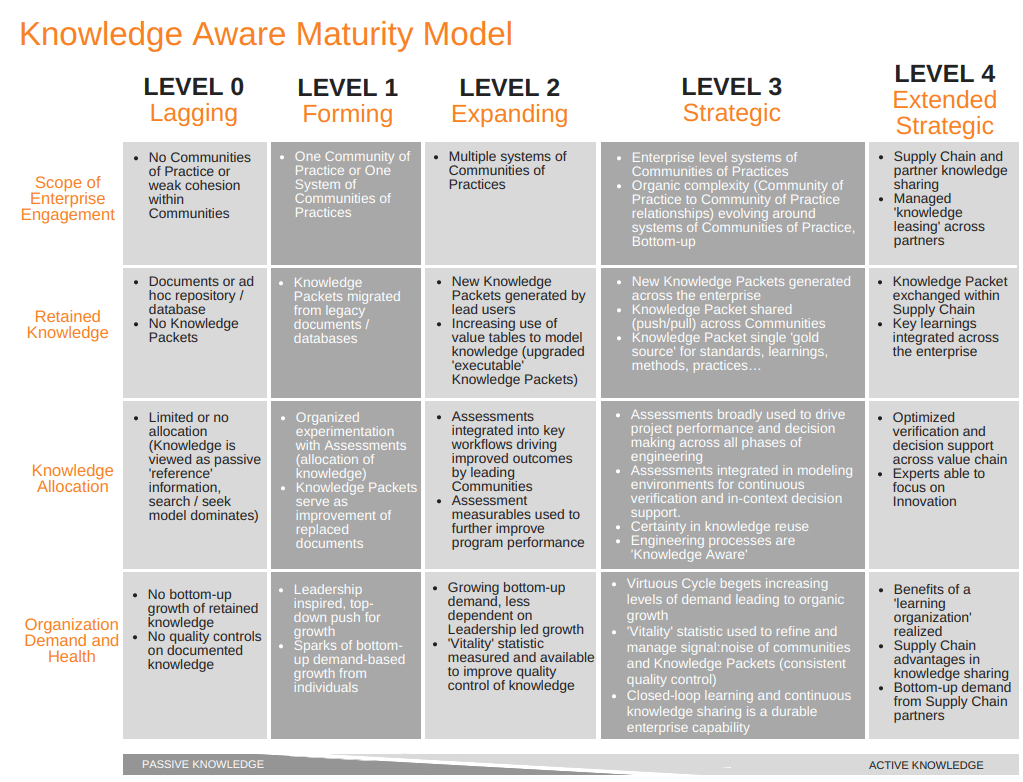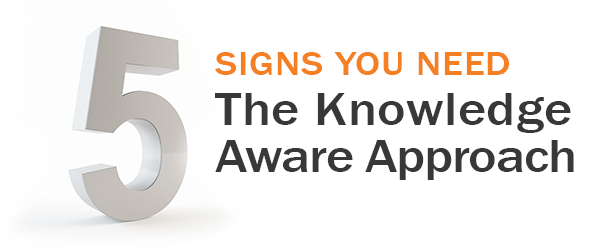Maintaining and utilizing important corporate knowledge is recognized as a competitive advantage. Because of this, knowledge management (KM) as a corporate discipline has become a key focus within organizations. Historically, KM efforts have focused on the practice of managing and organizing knowledge rather than the actual delivery of knowledge at the specific time and place that it’s needed. As a result, KM has been viewed as a separate effort, removed from everyday work processes, which doesn’t allow the efforts being taken to provide true value and improvement. Today, organizations continue to contemplate how to integrate knowledge sharing and collaboration, so the activities are integral parts of the work being done, rather than separate pursuits. The true value of corporate knowledge is only recognized when it is effectively provisioned and delivered back into the organization so it can be employed properly. So, how can we put knowledge seamlessly into the flow of work?
Over the years, best practices have been documented for implementing and operating effective KM processes that address these challenges. Some of these best practices include:
- Putting knowledge where people will “trip over it,” or where they can’t miss it
- Delivering knowledge in a format that fits the target audience
- Capturing experience and knowledge that are integral to the daily workflow
- Creating digital repositories to facilitate global standardization and knowledge reuse
These best practices are all represented in the newest take on knowledge management— the Knowledge Aware approach.
Introducing Knowledge Aware
Knowledge Aware (KA) is a new approach in efforts to effectively capture, manage, maintain, and provision critical knowledge, specifically at the time and location that it’s required. It replaces the traditional, passive reference shelf model with an integrated, active knowledge system that directly impacts technical decision-making and analysis.
As its name implies, the Knowledge Aware approach provides “awareness” and focuses on the provisioning of relevant corporate technical memory to the consumer at the point of decision, thus enabling them to deliver quality results, using a more efficient process. The cornerstone of KA is its ability to harvest bits of technical memory that are directly related to the workflow, package it, and provision it to provide real time, enterprise-wide, in context decision support. Unlike the traditional reference shelf paradigm that relies on an individual to initiate searches, KA provides decision support by dynamically provisioning the technical memory directly into all types of workflows.
With KA, technical memory is accumulated, consolidated, managed as an asset, and provisioned into context within a closed loop decision support operating system, allowing expertise to continually evolve within the enterprise. The technical memory is retained and delivered in both textual and digital form, allowing for direct delivery into digital representations of products and process, or through human interfaces to the engineer.
Engineers using Knowledge Aware do not sift through document repositories and databases in hopes of finding something useful. Instead, essential learnings and technical memory are allocated directly into existing workflows, giving engineers exactly what they need, when and where they need it, so they can make qualified and strong decisions.
GPS Navigation System Analogy
Knowledge Aware is replacing passive document-based strategies with managing knowledge in a way that is similar to the way mobile navigation has replaced paper maps. Consider the evolution of navigation over the past decade. Before the advent of GPS navigation systems, the standard approach for following a route to a specific destination was based solely on paper maps.
However, that approach had many limitations:

- Paper maps rapidly become out of date. These static representations of roads and intersections require constant updating to include new routes or modifications. Because of the effort and time required to modify and publish paper maps, they become obsolete shortly after they’re released.
- Paper maps lack context. They can’t recognize location, speed, or direction. As a result, they can’t provide the driver with an assessment of progress or feedback, or inform them whether or not they are still on the correct course.
- Paper maps present all information at one time. They include all relative information that is available for a specific geographic area, including intersections, interstates, streets, bodies of water, and anything else that needs to be considered when defining a route. As a result, there is the possibility of human error.
- Maps are impossible to use while driving because the information isn’t automatically delivered. It is unsafe and careless to try to reference a map while driving. Even if you have a passenger that is using the map and giving you directions, it is still inefficient. If a turn is missed or there’s a detour on the route, the passenger must find your location on the map, scan for alternative routes, and provide instructions to the driver, all in a timely manner before missing another turn.
Now consider how GPS navigation systems differ from paper maps:

- Navigation systems are dynamic and continuously updated to include any changes that may alter a route, including construction detours, new roads, and traffic backups.
- Navigation systems provide context. They monitor your location for the duration of the trip and give turn-by-turn instructions based on where you are at any given time. If a wrong turn is made, the GPS is able to recalculate your route within seconds and get you back on track.
- Navigation systems are safer to use while driving than paper maps. GPS systems use a computer-generated voice to instruct you where you need to go, rather than having to take your eyes off the road and look for your next turn on a map. The information is delivered to you verbally, rather than having to search for it yourself.
Structurally, the GPS system delivers information to the driver in bite-sized segments as it’s needed, as opposed to paper maps where all the information is captured in one large document.
Knowledge Aware is like a navigation system for technical memory. The technical memory is restructured into granular units, called Knowledge Packets, that can be easily managed and life cycled. This also allows only relevant knowledge to be delivered to the engineer, when required, rather than delivering a document that needs to be reviewed for pertinent information. It also simplifies knowledge management, because when revisions to the knowledge are required, it is limited to the specific Knowledge Packet rather than requiring an entire document to be republished.
Knowledge Aware Maturity Model
The Knowledge Aware Maturity Model (KAMM) is an instrument to help organizations determine their level of maturity with regards to institutionalizing their most valuable asset, corporate technical memory, in accordance with the principles of the Knowledge Aware system.

The Maturity Model consists of three important components:
The first important component of the Maturity Model contains the four key organizational features. These contain groups of related processes and elements that are instrumental to the institutionalization of KA within an organization. The four key organizational features are defined as follows:
- The Scope of Enterprise Engagement feature, which addresses the scope of Knowledge Aware across the enterprise.
- The Retained Knowledge feature, which addresses the enterprise’s commitment and ability to capture, retain, and validate technical memory.
- The Knowledge Allocation feature, which addresses the organization’s processes and commitment to consistently deliver technical memory when and where it is needed and assess its application within the enterprise’s everyday workflows.
- The Organization Demand and Health feature, which addresses the level of institutionalization of Knowledge Aware into an organization’s everyday workflows.
The second important component refers to the five maturity levels. The term “maturity” relates to the degree of formality and optimization of processes. By assessing the maturity of different aspects of Knowledge Aware, it becomes clear what their strengths and weaknesses are, and where improvements are needed. The five maturity levels designated within the maturity model are defined as follows:
- Lagging (Level 0) – There is essentially no organized level of managing or utilizing the corporate technical memory. Processes related to knowledge management are typically undocumented and strictly local in nature. As a result, they are dependent upon individuals and are in a state of dynamic change, providing an uncontrolled environment.
- Local/Tactical (Level 1) – There is an initial recognition of the need for managing or utilizing corporate technical memory. Although still at the local level, there is an effort to apply structure that would address some ownership of the technical memory. Processes at this level still lack formalization.
- Replicating/Expanding (Level 2) – There is some stability in the processes for allocating and assessing knowledge. These processes have moved beyond being local and now extend to some degree across disciplines and organizations. Metrics related to the “vitality” and application of the technical memory are pervasive, furthering improving program performance.
- Strategic (Level 3) – Corporate commitment exists throughout the organization. Knowledge management is no longer considered a process of its own and is instead integrated within the organization’s daily processes.
- Extended Strategic (Level 4) – The corporate commitment and application extends beyond the traditional boundaries of the enterprise. Bidirectional knowledge sharing with the supply chain further enhances the closed loop learning cycle. Decision verification, assessment, and decision support exist across the value chain.
The third key component of the Maturity Model is the Active vs. Passive Knowledge Index. This is a central theme of Knowledge Aware, which ensures that corporate knowledge is active rather than passive in delivery and structure.
Active vs. Passive Knowledge Provisioning
Companies can use many different approaches for managing and allocating corporate knowledge within their organizations. These include both physical and electronic libraries, collaborative document repositories, training sessions, access to technical experts, and delivery through digital tools such as CAD. The effectiveness of these approaches depends on whether the particular application of the KM system is time-sensitive. For instance, if the objective is to view knowledge for research, the acquisition and application of the knowledge is not typically time-critical. In comparison, for KM applications that support operational workflows, such as production, design, maintenance, and repair, the provisioning and application of knowledge becomes very time-critical.
In KM applications that are time-critical, it’s important that time isn’t lost searching for knowledge or interpreting how it should be applied. The Active vs. Passive Knowledge Index was developed to help realize this concept and to address organizations’ overall achievements to institutionalize processes that drive Active Knowledge Delivery and Active Knowledge Structure. Active Knowledge Delivery refers to the process in which knowledge is actively delivered to the individual rather than requiring them to search for the knowledge online, in files, or within hard copies of documents. Active Knowledge Structure refers to the process in which knowledge is documented so that it is intrinsically active, meaning that its application is direct and unambiguous. There is little to no need for the individual to interpret the meaning of the technical memory and how it needs to be applied.
A passive KM approach has limited to no knowledge delivery or provisioning. Knowledge is viewed as passive reference information. As a result, the traditional search model dominates. At the other end of the scale, an active KM approach is designed to provision relevant knowledge directly into workflows when and where it’s needed. Knowledge is not managed in documents, but as individual elements that can be harvested, networked, and delivered in packages to the user.
Virtual Reality and Augmented Reality
Virtual reality (VR) and augmented reality (AR) are similar in nature and share similar technologies. However, they address different types of work processes and they both can support the concept of active knowledge provisioning.
VR can be defined as the immersion of a user into a controlled virtual environment where they can interact with and manipulate virtual objects. VR has a proven track record for positive knowledge transfer and training for skilled trades. By isolating a user in a virtual world, they can focus on the task at hand and master their trade skills. Integrating haptic feedback into the VR-based training further enhances the user’s experience by involving additional senses, rather than just sight. Beyond training, VR can also be useful in areas such as design verification, visualization, environment simulation, diagnostics, and more. For example, in the shipbuilding and automotive industries, VR can be used throughout the design cycle, from beginning concept to final implementation.


AR can be defined as the integration of the virtual world with the real world. The user can see the real world around them as they normally would, while virtual objects are superimposed into the real world as well. Just in the area of training alone, AR can have a large impact in industries that require workers to perform location-specific tasks in an environment that can be represented virtually. This advantage makes AR a great candidate for training in industries that involve manufacturing, diagnostics, maintenance, and repair. Additionally, AR technology can have a profound impact in fields such as gaming, medicine, navigation, advertising, and more. Within maintenance and repair, AR allows the user to have applicable and relevant information at their fingertips, including access to a remote expert.
By eliminating the need to carry physical documents, the user can concentrate on their task, as everything needed can be digitally available in the AR and or VR application. The user is provisioned a step-by-step guide of how to perform tasks, as well as how to troubleshoot these tasks. An example of this is the National Shipbuilding Research Program (NSRP) sponsored Shipyard Mobile Applications in Real Time (SMART) project. A location-aware AR application was developed, without using a GPS, Wi-Fi, or Bluetooth to allow the importation of documents that were associated with specific ship compartments. From an end user point of view, this eliminated the need to carry large amounts of technical paperwork, as it was stored in digital form on a tablet and readily available to the user when they entered the appropriate compartment. As a result, AR and VR can address the first three best practices identified above:
- Putting knowledge where people will “trip over it,” or where they can’t miss it
- Delivering the knowledge in a format that fits the target audience
- Capturing experience and knowledge that are integral to the daily workflow
However, while AR and VR can be implemented in isolation, such short-sighted platforms have limitations, including their inability to understand how much information to present to the user. Alone, these technologies fail to address the fourth best practice:
- Creating digital repositories to facilitate global standardization and knowledge reuse
In terms of the Knowledge Aware Maturity Model, such a system will never achieve a level higher than Level 1: Local and Tactical. Without the integration of a KA system, the knowledge available to the end user is limited to what is stored on a physical device. In result, only scenarios anticipated in advance can be addressed in an AR or VR session. True diagnostics and learning on location are severely limited.
By integrating a Knowledge Aware system with AR and VR, we can provide a true active knowledge provisioning environment. Using AR and VR technologies to define the environment, procedures, and tools that the user is working with, the integrated KA system would be able to provision all relevant information back to the user, based on its current environment rather than a predefined environment. Through this merger, the user has the information needed in readily available digital format, without having to worry about the relevancy of the information being presented. Because the information is directly related to the user’s task, they are no longer overwhelmed with data or forced to search through a large volume of documents for the correct details.
Next: Combining Knowledge Aware with AR and VR
The next evolutionary step for the future of knowledge management is the incorporation of Knowledge Aware, artificial intelligence (AI), augmented reality, and virtual reality. This integration will enable the system to observe users in the work environment and adapt based on the user’s needs. In terms of training, the AI system can watch the user go through different training exercises and store performance metrics in a KA database as lessons learned. The VR training simulation is then updated based on these lessons learned. With AR, the AI system can observe user performance and user input and compare against previous metrics to ensure fidelity and perform error checking.
AR and VR can offer endless possibilities to increase workflow efficiency and minimize risks, but when combined with the Knowledge Aware approach, productivity is truly maximized. Employees are given exactly what information they need at the appropriate time to complete their tasks correctly, while utilizing the latest technology to make design processes, repairs, diagnostics, training, and many other processes and procedures run as smoothly as possible. In turn, this saves time and money, decreases the margin for error, and increases product quality and employee safety.





Comments are closed.